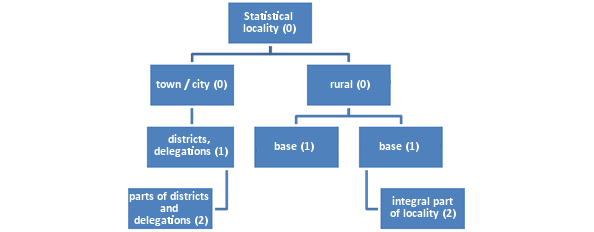Data as of 09th October, 2025
User: Guest
- DATA
- METADATA
- API
- ARCHIVE
- HELP
Statistical locality constitutes a set, singled out for statistical purposes,
of localities usually consisting of a village and adjacent hamlets or other smaller localities
for which statistical data are collected and processed jointly.
It is usually identified by the mutual name of the larger locality.
In certain cases, this may consist solely of one locality (see diagram below – locality code is in brackets).

Locality code:
- - for rural localities:
- 0 – statistical locality
- 1 – base locality
- 2 – integral part of locality
- - for towns/cities:
- 0 – town/city
- 1 – districts of the capital city of Warszawa, delegations in Kraków, Łódź, Poznań, Wrocław, districts of remaining cities/towns
- 2 – parts of districts in the capital city of Warszawa and in delegations
The issue of localities is regulated by the Act of 29 August 2003 on official names of localities and physiographic objects
(Journal of Laws of 2003 No. 166, item 1612 and of 2005 No. 17, item 141 with further amendments).
The Act defines the basic terms in this area.
Locality – a settlement unit or other settled area, differentiated from other localities with a separate name,
and in case of an identical name - different denotation of their type.
Type of locality – denotes the character of the locality, developed in the settlement development process, in particular:
town/city, settlement, village, farmstead, colony, hamlet and their parts.
The definitions of different types of localities specified in the Act imply division of localities into two main categories:
- stand-alone localities, called „basic” in the TERYT register,
- non-stand-alone localities, so called integral parts of localities, each of which belongs to a particular basic locality.
In selected cases the stand-alone character of a locality is linked to its type, hence:
- town/city and village – are always stand-alone settlement units,
- part of town/city, part of village and hamlet and settlement – are integral parts of locality;
when mentioning a particular name one should always indicate the name of the basic locality eg.:
part of town/city, district, hamlet or settlement that is a part of village,
- farmstead or colony – have a dual character: they can constitute stand-alone settlement units
or integral parts of a particular village, thereafter referred to as farmstead or colony or village.
Assignment to the basic locality is conducted primarily on the basis of ordinal numbering
of real estate property – buildings situated in a locality belonging to a different locality are numbered according
to the numbering of their basic locality, or included in its street network.